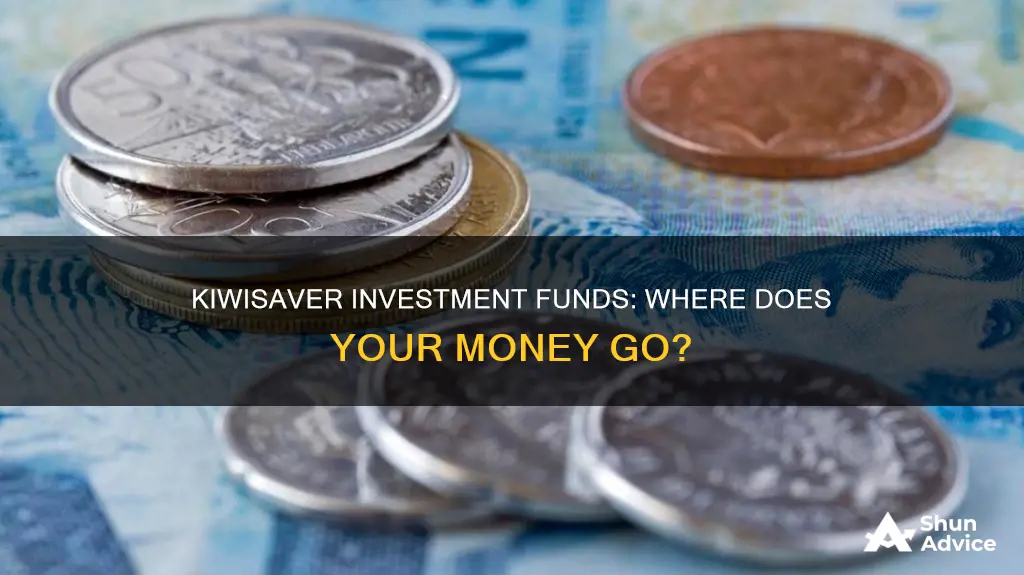
KiwiSaver is a voluntary savings scheme set up by the New Zealand government to help New Zealanders save for their retirement. With over 3 million members, KiwiSaver is an investment smash. There are 3.25 million KiwiSaver members, who have $93.7 billion invested across 38 schemes. There are over 300 different funds, offering a wide range of investment options, growth strategies and different levels of risk. KiwiSaver funds are a form of managed fund, so they share their features and advantages. However, KiwiSaver funds have specific rules built in that make them worth comparing separately.
The right type of fund for an individual depends on their situation, the level of service and communication, and the fund's performance compared to others like it.
| Characteristics | Values |
|---|---|
| Number of members | 3.25 million |
| Amount invested | $93.7 billion |
| Number of schemes | 38 |
| Number of funds | 300+ |
| Top 10 funds by number of members | ANZ KiwiSaver Growth Fund, ASB KiwiSaver Growth Fund, Westpac KiwiSaver Conservative Fund, ASB KiwiSaver Conservative Fund, Westpac KiwiSaver Growth Fund, Fisher Funds KiwiSaver Growth Fund, ANZ KiwiSaver Balanced Growth Fund, ANZ KiwiSaver Balanced Fund, Booster Socially Responsible Investment High Growth Fund, Westpac KiwiSaver Balanced Fund |
| Top 5 funds by 5-year returns | QuayStreet Conservative Fund, Generate Moderate Fund, Milford Balanced Fund, Milford Active Growth Fund, Booster SRI High Growth Fund |
| Top 10 funds average 12-month return | 7.64% |
| Top 10 growth funds average 12-month return | 9.24% |
| Number of funds by risk profile | Conservative Fund, Moderate Fund, Balanced Fund, Growth Fund, Aggressive Fund |

Conservative funds
The average annual return of QuayStreet's Conservative Fund over five years as of 31 March 2024 was 3.88%, while the average annual return on the market index is 4.91%.
RIA Mutual Fund Investment: What's the Catch?
You may want to see also

Moderate funds
The Generate Moderate Fund, for example, had an average annual return of 5.10% over ten years as of 31 March 2024, while the market index average was 5.99%. As of March 2024, the Generate Moderate Fund's asset allocation was as follows: 60% international and Australasian equities, 20% international fixed interest, 10% Australasian fixed interest, 5% cash and cash equivalents, and 5% other.
The ASB KiwiSaver Scheme's Moderate Fund, meanwhile, aims for moderate total returns, with a higher number of years with negative returns than the Conservative Fund but lower than the Balanced Fund. This fund invests in more income assets than growth assets, and moderate ups and downs in your balance are expected.
IRA and Mutual Funds: A Smart Investment Strategy
You may want to see also

Balanced funds
The KiwiSaver Balanced Fund is a diversified fund that invests in a mix of growth and income assets. The objective of this fund is to deliver appropriate risk-adjusted returns over both the short and long term, aiming for moderate to high total returns. The minimum suggested investment timeframe is 5-6 years, indicating a medium to high-risk investment strategy.
The fund's asset mix typically includes a larger proportion of growth assets, such as shares, property, and other alternative investments, with a target allocation of around 55%-60%. These growth assets provide higher potential returns but come with greater risk and volatility. Within the growth asset category, international shares and equities usually make up a significant portion, often around 40%-45%, followed by New Zealand shares at approximately 10%-15%. The fund may also have a smaller allocation to unlisted property investments, adding further diversification.
On the income side, the fund invests in bonds, cash, and cash equivalents, typically making up around 40%-45% of the total asset mix. These income assets provide a more stable and consistent return, helping to balance out the riskier growth assets. Within income assets, fixed-interest securities, including international and New Zealand fixed interest, are a significant component, often targeted at around 20%-25%. Cash and cash equivalents make up a smaller portion, usually about 2%-10%, providing liquidity and stability to the portfolio.
The specific asset mix and investment strategy can vary depending on the fund provider and market conditions. For example, the ANZ KiwiSaver Scheme Balanced Fund reported that as of 31 March 2024, their asset mix included 42% equities, 6% listed property, 40% fixed interest, 10% cash and cash equivalents, and 2% listed infrastructure.
It is important to note that the performance of the fund can vary, and past performance is not a guarantee of future results. Investors should carefully consider their risk tolerance and investment goals when choosing a KiwiSaver fund and seek financial advice if needed.
Maximizing Your Roth IRA Returns with Index Funds
You may want to see also

Growth funds
The Generate KiwiSaver Growth Fund, for example, aims to provide a high return over the medium to long term by investing primarily in growth assets with a small allocation to income assets. The fund's volatility is expected to be high, and returns may vary and be low or negative at times. As of 30 June 2024, the fund held a mix of growth and income assets, including international and Australasian shares, property, bonds, and cash.
Another example of a growth fund is the ANZ KiwiSaver Growth Fund, which had over 250,000 members and a value of nearly $5 billion as of June 2024. This fund invests mainly in growth assets, with a smaller exposure to income assets, and had a growth of 5.3% in the past year.
Income Funds: The Right Time to Invest
You may want to see also

High-growth funds
The Booster Socially Responsible Investment High Growth Fund, for example, has a target investment mix of 100% growth assets, including international and Australasian equities. The fund has delivered strong investment performance since its inception in 2007, with an average annual return of 9.30% over ten years as of 31 March 2024.
The Milford Active Growth Fund is another example of a high-growth fund. It strives for an annual net return of 10% for investors over a recommended investment period of no less than five years. The fund is classified as medium-to-high risk and diversifies by investing largely in equity and a reasonable amount of asset allocation in fixed-interest securities.
It is important to note that while high-growth funds aim for higher returns, there is also a higher level of risk and volatility involved. As such, these funds may not be suitable for those seeking stable returns or those who are approaching retirement.
Vanguard Funds: Best Bets for New Investors
You may want to see also
Frequently asked questions
There are five main types of KiwiSaver funds: Defensive, Conservative, Balanced, Growth, and Aggressive. These funds are grouped by how much of the more risky investments they hold, like shares and property.
It depends on your risk appetite, investment longevity, and goals. You can use a tool like the KiwiSaver fund finder to find the right type of fund for you and compare funds based on their fund type, costs, and past results.
Fees for KiwiSaver funds can add up to tens of thousands of dollars over the years. It's important to compare the costs of different funds and choose carefully. You can use a KiwiSaver fees calculator to forecast what you'll pay in fees over the life of your KiwiSaver experience.
If you want to switch to another fund with your existing provider, you may be able to do so online. If you want to switch to another provider, contact them directly and fill out a membership application. They will handle the rest of the process, including transferring your funds, which typically takes between 10 and 35 days.
You can check your existing returns on investment through your KiwiSaver login and compare them against the industry average and the best-performing funds in your fund category. If your returns are consistently below average, it may be time to consider switching funds.







